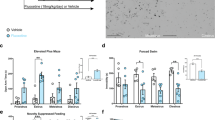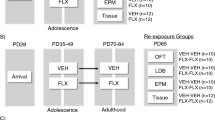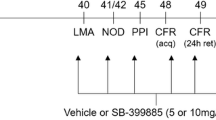Abstract
Rationale
Antidepressant treatments are commonly prescribed, but few studies have been published, even in animal models, on differences in reactivity to antidepressants with respect to rearing environment and sex.
Objectives
Using a mouse model, we investigated the hypothesis that rearing environment (weaning time) and sex could impact responses to imipramine treatment.
Methods
ICR mice were assigned to four groups for each sex: early weaned saline or imipramine treated, normally weaned saline or imipramine treated. Early weaning was conducted on postnatal day 14. All groups were injected intraperitoneally with drug or vehicle for 2 weeks from the age of 6 weeks and tested in the elevated plus maze to estimate anxiety levels. Hippocampal neurogenesis was also assessed with immunostaining for calretinin and calbindin because it has suggested that neurogenesis is required for the behavioral effects of antidepressants.
Results
Imipramine treatment decreased anxiety levels in females, but not in males, in the normal weaning condition. By contrast, the same treatment decreased anxiety levels in males, but not females, in the early weaning condition. Hippocampal changes, which correlated these behavioral responses to imipramine, were seen in the extragranule cell layer: the number of calretinin-positive cells was increased by imipramine in females, but not in males, in the normal weaning condition. In the early weaning condition, however, the treatment was associated with similar changes in males but not in females.
Conclusions
The results suggest that rearing environment and sex differences are implicated in responses to imipramine treatment with respect to anxiety behavior and neurogenesis in the hippocampus.



Similar content being viewed by others
References
Baca E, Garcia-Garcia M, Porras-Chavarino A (2004) Gender differences in treatment response to sertraline versus imipramine in patients with nonmelancholic depressive disorders. Prog Neuropsychopharmacol Biol Psychiatry 28:57–65
Becker JB, Hu M (2008) Sex differences in drug abuse. Front Neuroendocrinol 29:36–47
Brandt MD, Jessberger S, Steiner B, Kronenberg G, Reuter K, Bick-Sander A, von der Behrens W, Kempermann G (2003) Transient calretinin expression defines early postmitotic step of neuronal differentiation in adult hippocampal neurogenesis of mice. Mol Cell Neurosci 24:603–613
Bruder GE, Sedoruk JP, Stewart JW, McGrath PJ, Quitkin FM, Tenke CE (2008) Electroencephalographic alpha measures predict therapeutic response to a selective serotonin reuptake inhibitor antidepressant: pre- and post-treatment findings. Biol Psychiatry 63:1171–1177
Cryan JF, Holmes A (2005) The ascent of mouse: advances in modelling human depression and anxiety. Nat Rev Drug Discov 4:775–790
De Bellis MD, Keshavan MS (2003) Sex differences in brain maturation in maltreatment-related pediatric posttraumatic stress disorder. Neurosci Biobehav Rev 27:103–117
Heim C, Newport DJ, Wagner D, Wilcox MM, Miller AH, Nemeroff CB (2002) The role of early adverse experience and adulthood stress in the prediction of neuroendocrine stress reactivity in women: a multiple regression analysis. Depress Anxiety 15:117–125
Hodes GE, Hill-Smith TE, Suckow RF, Cooper TB, Lucki I (2010) Sex-specific effects of chronic fluoxetine treatment on neuroplasticity and pharmacokinetics in mice. J Pharmacol Exp Ther 332:266–273
Ito A, Kikusui T, Takeuchi Y, Mori Y (2006) Effects of early weaning on anxiety and autonomic responses to stress in rats. Behav Brain Res 171:87–93
Janus K (1987) Effects of early separation of young rats from the mother on their open-field behavior. Physiol Behav 40:711–715
Kalinichev M, Easterling KW, Plotsky PM, Holtzman SG (2002) Long-lasting changes in stress-induced corticosterone response and anxiety-like behaviors as a consequence of neonatal maternal separation in Long–Evans rats. Pharmacol Biochem Behav 73:131–140
Kempermann G, Kuhn HG, Gage FH (1997) Genetic influence on neurogenesis in the dentate gyrus of adult mice. Proc Natl Acad Sci USA 94:10409–10414
Kessler RC, Angermeyer M, Anthony JC, De Graaf R, Demyttenaere K, Gasquet I, De Girolamo G, Gluzman S, Gureje O, Haro JM (2007) Lifetime prevalence and age-of-onset distributions of mental disorders in the World Health Organization’s World Mental Health Survey Initiative. World Psychiatry 6:168–176
Khan A, Brodhead AE, Schwartz KA, Kolts RL, Brown WA (2005) Sex differences in antidepressant response in recent antidepressant clinical trials. J Clin Psychopharmacol 25:318–324
Kikusui T (2011) Emotionality-related consequences of early weaning in mice and rats. In: Gould TD (ed) Mood and anxiety related phenotypes in mice II. Human Press, New York, pp 225–234
Kikusui T, Mori Y (2009) Behavioural and neurochemical consequences of early weaning in rodents. J Neuroendocrinol 21:427–431
Kikusui T, Takeuchi Y, Mori Y (2004) Early weaning induces anxiety and aggression in adult mice. Physiol Behav 81:37–42
Kikusui T, Nakamura K, Kakuma Y, Yuji M (2006) Early weaning augments neuroendocrine stress responses in mice. Behav Brain Res 175:96–103
Kikusui T, Kiyokawa Y, Mori Y (2007) Deprivation of mother–pup interaction by early weaning alters myelin formation in male, but not female, ICR mice. Brain Res 1133:115–122
Kikusui T, Ichikawa S, Mori Y (2009) Maternal deprivation by early weaning increases corticosterone and decreases hippocampal BDNF and neurogenesis in mice. Psychoneuroendocrinology 34:762–772
Kodama Y, Kikusui T, Takeuchi Y, Mori Y (2008) Effects of early weaning on anxiety and prefrontal cortical and hippocampal myelination in male and female Wistar rats. Dev Psychobiol 50:332–342
Kornstein S, Schatzberg A, Thase M, Yonkers K, McCullough J, Keitner G, Gelenberg A, Davis S, Harrison W, Keller M (2000) Gender differences in treatment response to sertraline versus imipramine in chronic depression. Am J Psychiatry 157:1445–1452
Malberg JE (2004) Implications of adult hippocampal neurogenesis in antidepressant action. J Psychiatry Neurosci 29:196–205
Malberg JE, Eisch AJ, Nestler EJ, Duman RS (2000) Chronic antidepressant treatment increases neurogenesis in adult rat hippocampus. J Neurosci 20:9104–9110
Martenyi F, Dossenbach M, Mraz K, Metcalfe S (2001) Gender differences in the efficacy of fluoxetine and maprotiline in depressed patients: a double-blind trial of antidepressants with serotonergic or norepinephrinergic reuptake inhibition profile. Eur Neuropsychopharmacol 11:227–232
Mendelsohn ME, Karas RH (2005) Molecular and cellular basis of cardiovascular gender differences. Science 308:1583–1587
Nakamura K, Kikusui T, Takeuchi Y, Mori Y (2008) Changes in social instigation-and food restriction-induced aggressive behaviors and hippocampal 5HT1B mRNA receptor expression in male mice from early weaning. Behav Brain Res 187:442–448
Ono M, Kikusui T, Sasaki N, Ichikawa M, Mori Y, Murakami-Murofushi K (2008) Early weaning induces anxiety and precocious myelination in the anterior part of the basolateral amygdala of male Balb/c mice. Neuroscience 156:1103–1110
Santarelli L, Saxe M, Gross C, Surget A, Battaglia F, Dulawa S, Weisstaub N, Lee J, Duman R, Arancio O, Belzung C, Hen R (2003) Requirement of hippocampal neurogenesis for the behavioral effects of antidepressants. Science 301:805–809
Shimozuru M, Kodama Y, Iwasa T, Kikusui T, Takeuchi Y, Mori Y (2007) Early weaning decreases play–fighting behavior during the postweaning developmental period of Wistar rats. Dev Psychobiol 49:343–350
Slabbert JM, Rasa OA (1993) The effect of early separation from the mother on pups in bonding to humans and pup health. J S Afr Vet Assoc 64:4–8
Sloviter RS (1989) Calcium-binding protein (calbindin-D28k) and parvalbumin immunocytochemistry: localization in the rat hippocampus with specific reference to the selective vulnerability of hippocampal neurons to seizure activity. J Comp Neurol 280:183–196
Tanaka E (1999) Gender-related differences in pharmacokinetics and their clinical significance. J Clin Pharm Ther 24:339–346
Vermeiden M, van den Broek WW, Mulder PG, Birkenhäger TK (2010) Influence of gender and menopausal status on antidepressant treatment response in depressed inpatients. J Psychopharmacol 24:497–502
Wallace DL, Han MH, Graham DL, Green TA, Vialou V, Iniguez SD, Cao JL, Kirk A, Chakravarty S, Kumar A, Krishnan V, Neve RL, Cooper DC, CA B, Barrot M, McClung CA, Nestler EJ (2009) CREB regulation of nucleus accumbens excitability mediates social isolation-induced behavioral deficits. Nat Neurosci 12:200–209
Wigger A, Neumann ID (1999) Periodic maternal deprivation induces gender-dependent alterations in behavioral and neuroendocrine responses to emotional stress in adult rats. Physiol Behav 66:293–302
Worobec EK, Duncan IJH, Widowski TM (1999) The effects of weaning at 7, 14 and 28 days on piglet behaviour. Appl Anim Behav Sci 62:173–182
Yalcin I, Belzung C, Surget A (2008) Mouse strain differences in the unpredictable chronic mild stress: a four-antidepressant survey. Behav Brain Res 193:140–143
Acknowledgments
This work was supported financially by Grants-in-Aid for Scientific Research from the Ministry of Education, Culture, Sports, Science, and Technology of Japan (#s14760187 and 23248049) and partially supported by a research project grant awarded by the Azabu University.
Author information
Authors and Affiliations
Corresponding author
Rights and permissions
About this article
Cite this article
Mogi, K., Shimokawa, Y., Nagasawa, M. et al. Effects of sex and rearing environment on imipramine response in mice. Psychopharmacology 224, 201–208 (2012). https://doi.org/10.1007/s00213-012-2821-y
Received:
Accepted:
Published:
Issue Date:
DOI: https://doi.org/10.1007/s00213-012-2821-y




